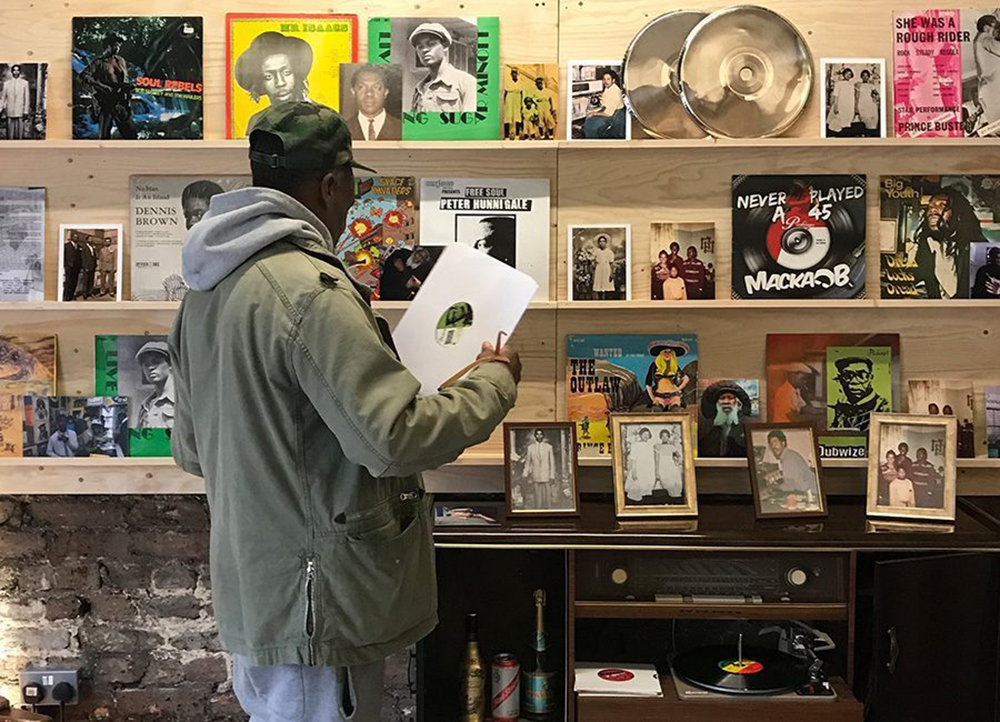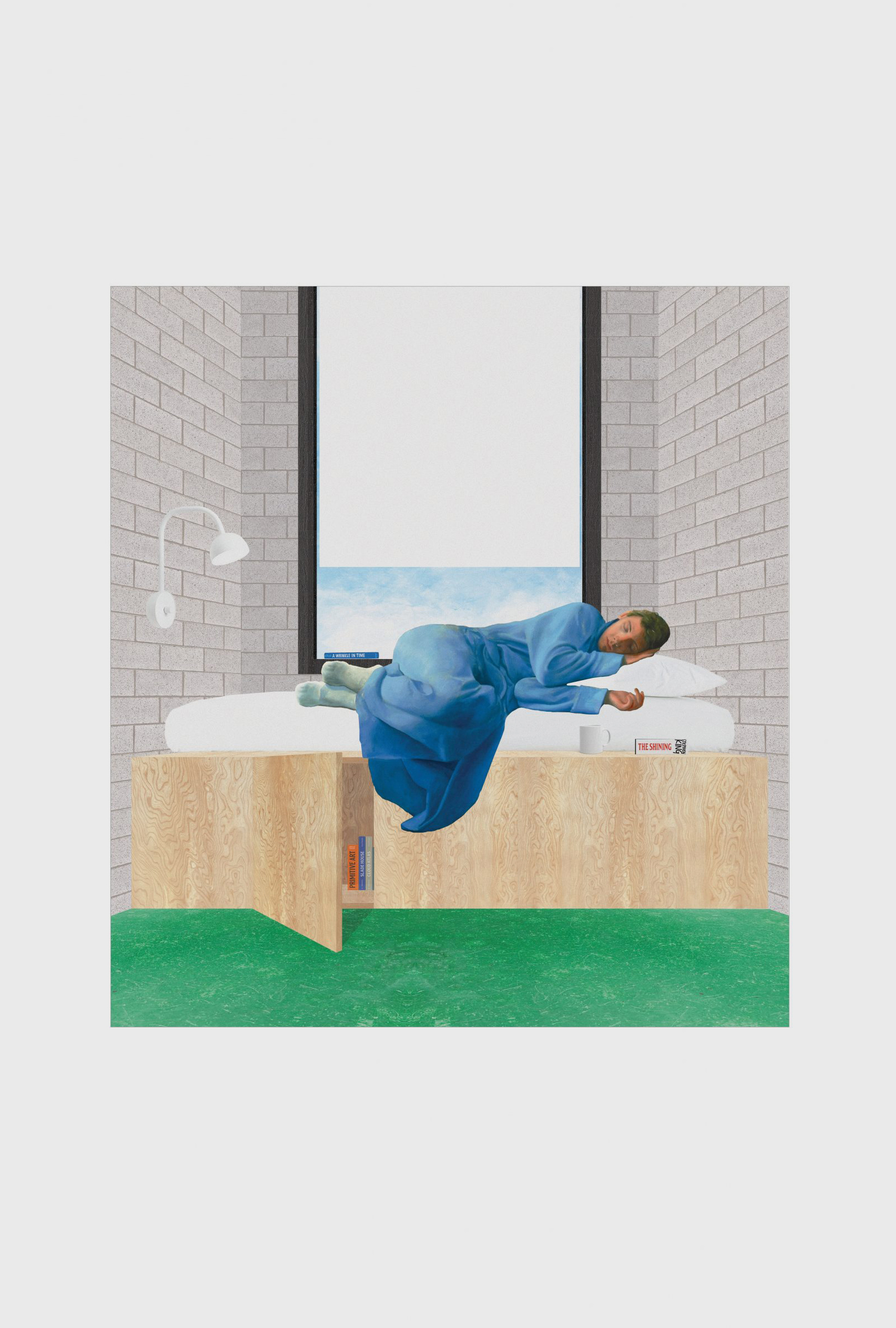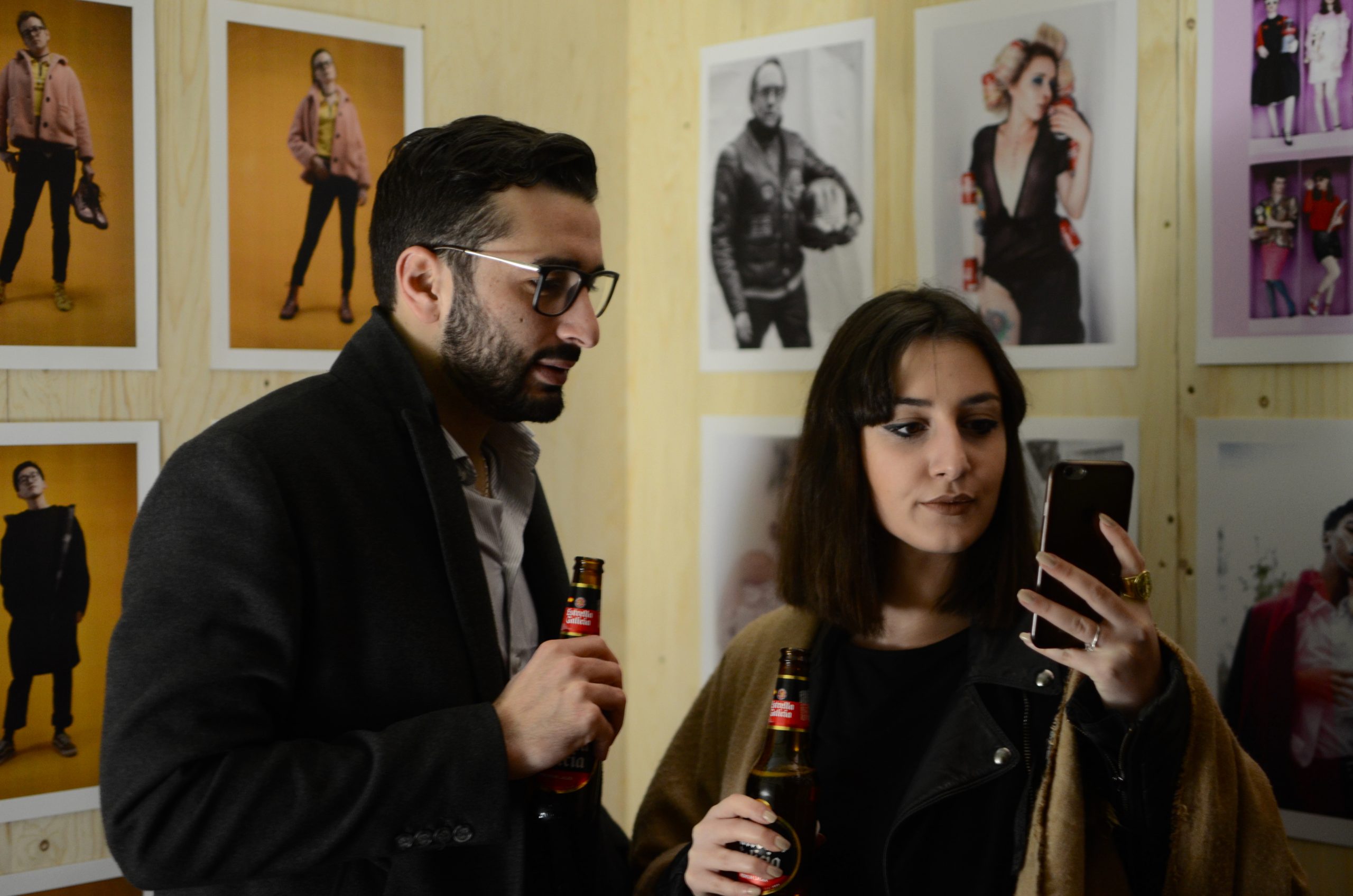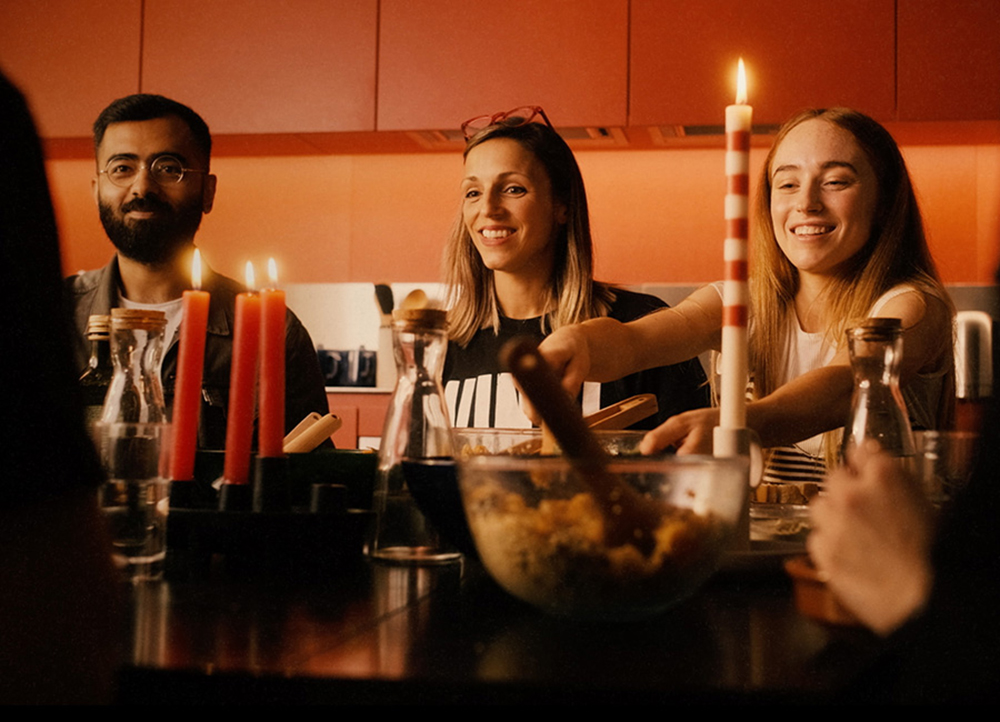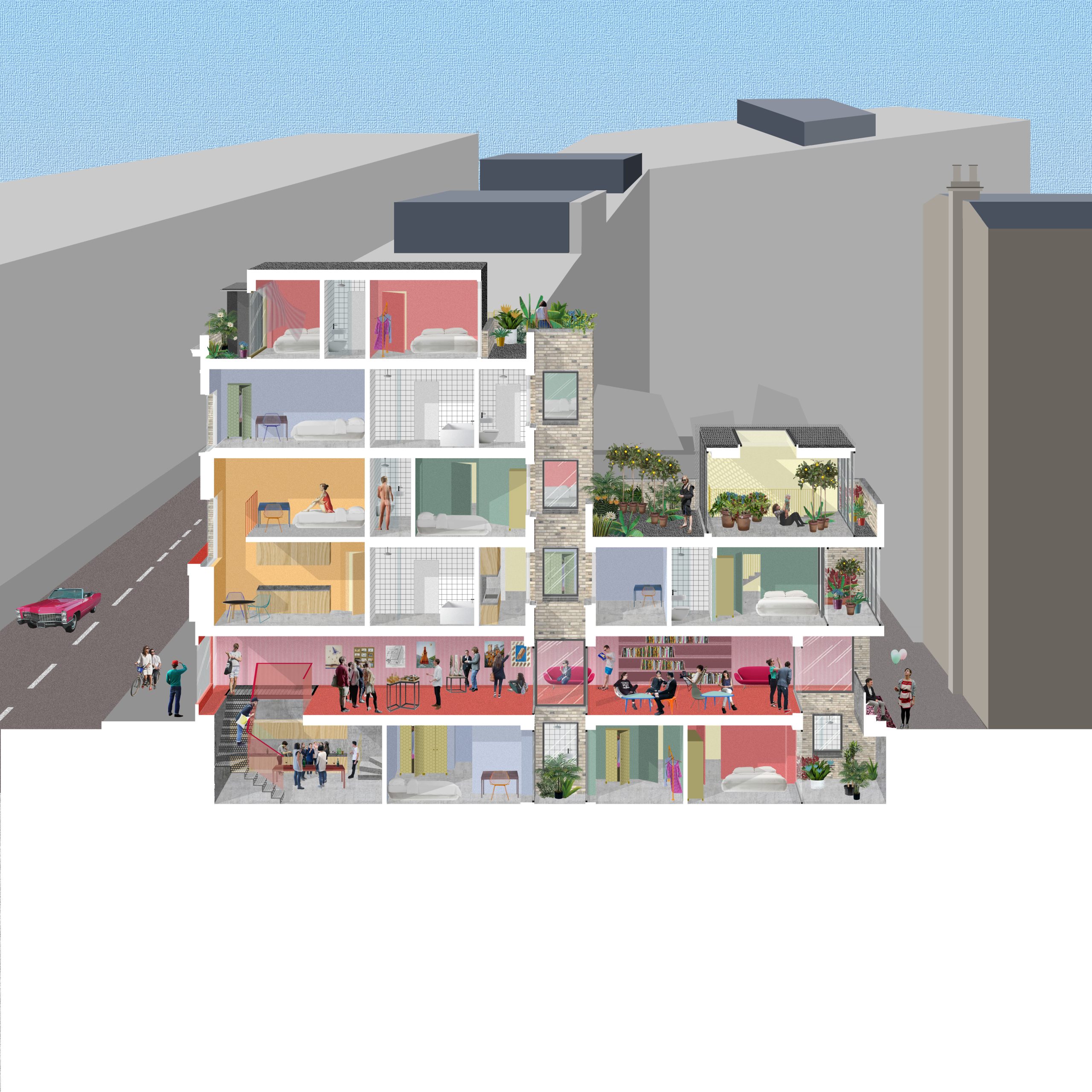
Architects and Noiascape founders Tom and James Teatum reveal the ideas that led them to create High Street House, a new model for urban renting, and explain their vision for a new type of residential architecture for London.
What is the City in a Building concept?
Tom Teatum: City in a Building is about the opportunity to take functions of the city that are typically separated – workspace, living space, social space and cultural space – and allow them to overlap in one building. We’re really interested in the idea of a space that is fluid and constantly changing, creating different experiences for the people that live there, but also allowing those people to contribute. High Street House is a micro-model of how that can happen, in a location where it can connect with an existing local community.
What led you to develop this concept?
James Teatum: The idea of a typology that can enable you to live, work and socialise in the same building has been in our minds for quite some time, even though for most people it has only become clear in the past two years, as they have started to experience working from home. Technology is enabling it to happen in a rapid way.
TT: We’re responding to a lot of projects that we’ve seen in London, which deal with the quality of the housing but not the actual experience of living there. Some housing developments have between 50 and 100 homes, but don’t create any place for people to connect apart from the entrance. We’ve seen people in buildings we’ve produced connecting through WhatsApp, so we knew there was a desire to take conversations into an actual space. We felt there was a way to organise space differently, to allow people to connect more frequently, but in a way that was subtle and not forced.
Do you have any research to support your ideas?
JT: We’ve been designing, developing and operating spaces for over a decade and have been pretty close to all the people that have lived in them. In 2018, we carried out a study to help us understand the nature of private space and how it was being used. We discovered that, excluding sleep, people were only spending 17 to 20 percent of the day in their homes. Of course that has changed since the pandemic, now that more people are working from home, but we think the research is still highly relevant. It shows that homes are not providing enough spaces for social interaction, even though the provision of public spaces in cities – pubs, libraries, community centres – is being eroded. This led us to consider how we could condense the private space and instead create new types of public and semi-public spaces in residential buildings.
TT: When we did this study, it was the beginnings of technology really starting to kick in, allowing people to work from home a lot more. But because living spaces were typically very cellular, they didn’t work for people who wanted to use their homes in different ways. We could see that we were going to start to need something very different. If large amounts of capital – both in terms of land and construction – go into producing space that is redundant 70 percent of the time, that’s really wasteful. We felt there could be a different way to distribute that capital, to produce spaces that are more efficient and also address the loss of social space in cities.
What have you learned from designing and managing High Street House?
TT: We’ve learned that the quality of private space is still really important. People need to know that they have their own territory and they want to be able to access shared spaces on their own terms. In High Street House, the shared space is visible and accessible, but it’s not presented as something that residents have to use and that’s important.
It’s also important that the private spaces reflect the different requirements for different users, from couples to singles, and from people that have just graduated to those who are further on in life and want slightly more space. We’ve got a range of spaces in terms of architecture. Some are double-height, some are connected to a terrace and some are more conventionally on one level. That range means we have the ability to have a mixture of people coming to live.
We’ve also learned that shared space is both something that’s programmed, like an event or an exhibition, but it’s also something that is very soft. It can be a window seat where people can see others coming in and out, and say hello. It’s a very soft gesture but it’s a reassurance that you know the people where you live. That plays a big part in feeling connected to a place.
Do you think the fundamental concept of home needs to change?
TT: It’s different for different groups. We can see a disparity between people who want to make a home, who are predominantly families, and those who are using the city in a very different way. Someone who is thinking about a home for three months or a year is very different to someone who wants to build a home for a family and live in the area for 10 years or more.
JT: The idea of home is not necessarily about ownership, it can be more experiential, and that’s where the social element comes in. If someone is going to live somewhere for a short period of time – and 12 months is a short amount of time in the context of life – what are they looking for? It’s then that the experiential part becomes really important.
Who do you think the City in a Building concept is best suited to?
JT: I think it works for a certain group of people. The idea of flexibility and convenience is across everyone that stays in our spaces. Age is irrelevant. There is a whole range of people who, for whatever reason, are at a point in their life where they want to be flexible and be around other people. We’ve had residents who were 70 years old and here in London for a specific reason; they were at an educational food course locally. Their age had nothing to do with why they were here, it was about this typology offering what they needed. We’ve also had residents who have just graduated.
What needs to happen for this model to become more widespread?
JT: It’s a learning process. There aren’t many of these spaces yet in London or globally, but once we get to a stage where more people are able to experience this, it becomes much more commonplace. Co-working wasn’t a thing 10 years ago, but people are pretty familiar with what that means now. We’re all now familiar with the idea of subscribing to different channels for TV and film, but 10 years ago it wasn’t so common.
TT: It’s about the way we assess value in terms of investment. We’ve got maybe four different businesses operating out of High Street House and we’re platforming various young people who are involved in visual arts. But the ability for this building to act as an incubator for young talent is not something that shows up on a balance sheet. We need to find a way to communicate all the value we create beyond the financial. This building actually has an impact on the area. Where we’ve lost the library, we don’t have anywhere for live music and we’ve lost flexible space that can be rented out for a few hours, this typology can replace that. It offers a new way to bring benefits to the local economy and to local culture.
Do you think the pandemic will impact the demand for this type of living?
TT: What has become really evident in the past two years is that the relationship between work and where you live is broken. It seems to be universal across ages and different types of work. Before, people’s choices about where to live were connected to a physical place of work, and now that has changed. This typology is ideally placed to support people who have been freed from having to go to a place of work. It’s saying they can live and work in the same building, and it’s also providing places where they can meet and interact with other people. For those whose lives are largely in the digital sphere, in terms of communications and connections, there’s also a hunger to actually meet people.
JT: People search for what they consider to be authentic experiences or scenarios. We’ve all evolved over the last decade, spending much more time online for work and for social purposes. People increasingly want to be in a room with other people, and even more so in the past two years. But based on the inquiries we see coming into Noiascape, it feels like that option isn’t really out there. So a typology that can allow you to live comfortably, to work in the way you need to and provides opportunities to meet people and access events, is really compelling. We get inquiries daily and these are common themes every time.
Share this article
Keep Reading…
Stay with Noiascape from
one month to a year.
Tell us about you, where you want to stay, what you need, or just ask a general question.
Collaborate with
Noiascape
Use our social spaces as a way to find your audience and contribute to your local culture.
Enquiry successfully submitted
Thanks for contacting us.
We’ll get back to you within 24 hours
Enquiry successfully submitted



